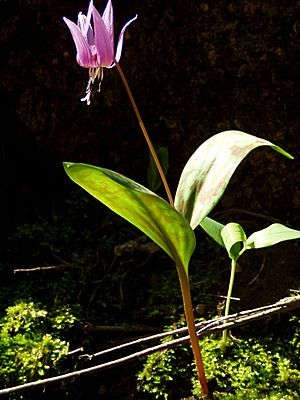Dog's tooth violet facts for kids
Quick facts for kids Dog's tooth violet |
|
|---|---|
 |
|
| Scientific classification | |
| Genus: |
Erythronium
|
| Species: |
dens-canis
|
The Dog's-tooth-violet (also called dogtooth violet) is a beautiful flowering plant. Its scientific name is Erythronium dens-canis. This plant grows from a bulb, like a tulip, and comes back every year. It can grow up to 25 centimeters tall.
You can find it naturally in central and southern Europe, from Portugal all the way to Ukraine. It's the only type of Erythronium plant that grows wild in Europe. Even though it's called a 'violet,' it's not actually related to the true violets you might know.
What Does It Look Like?
The Dog's-tooth-violet usually has one flower that blooms in early spring. The flowers can be white, pink, or a light purple color. Their petals are about 3 centimeters long and curve backwards. The base of the petals often has a yellow tint.
This plant has two leaves that grow in pairs. They are shaped like an oval or a spear and have brown spots. The plant's white bulb looks a lot like a dog's tooth. This is why it's called "dog's tooth violet." The Latin part of its name, dens-canis, also means "dog's tooth."
Where Does It Grow?
You can find the Dog's-tooth-violet in places that are a bit damp and have some shade. It often grows in forests where trees lose their leaves in the fall.
How Is It Used?
People can eat the leaves of the Dog's-tooth-violet. You can eat them raw in a salad or cook them like other leafy vegetables. The bulb of the plant is also used to make a type of starch. This starch can be used to make vermicelli, which are thin noodles.
See also
 In Spanish: Erythronium dens-canis para niños
In Spanish: Erythronium dens-canis para niños

